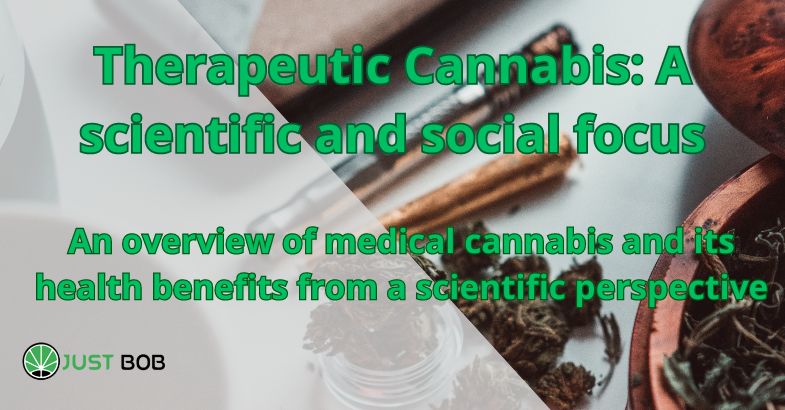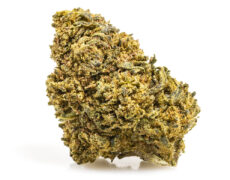Modified on: 15/02/2024
An overview of medical cannabis and its health benefits from a scientific perspective
Medical cannabis, often referred to as medical marijuana, is a topic of growing interest in the scientific and medical community. A significant distinction should be made between medical cannabis and recreational cannabis, which primarily depends on its intended use. While cannabis has historically been used for recreational purposes, its therapeutic potential is emerging through a series of studies highlighting its beneficial properties for human health, and is officially used for relieve symptoms of many deseases.
In addition to this specific application, well-documented by scientific literature, there are also studies on the advantages of using cannabis for chronic pain control and the management of muscle spasms, which are common in multiple sclerosis patients.
This article will explore the landscape of medical cannabis from a scientific perspective, highlighting the evidence supporting its medical use.
Medical Marijuana: Derived from Cannabis Sativa plant
Medical marijuana, an increasingly popular topic in healthcare, has garnered significant attention due to its potential therapeutic benefits. It is primarily derived from the Cannabis sativa plant, one of the two major species of the cannabis plant.
Cannabis sativa has been utilized for centuries for various purposes, including medicinal use. This plant contains a rich array of chemical compounds called cannabinoids, which are responsible for many of its effects. Two of the most well-known cannabinoids are delta-9-tetrahydrocannabinol (THC) and cannabidiol (CBD).
One of the significant advantages of Cannabis sativa plant in medical marijuana is its CBD content. CBD is a non-psychoactive compound with proven anti-inflammatory and analgesic properties. Unlike THC, it doesn’t induce the characteristic “high” associated with recreational cannabis use. This makes CBD-rich strains of Cannabis sativa particularly appealing for medical purposes, as patients can experience therapeutic effects without the intoxicating side effects.
Medical marijuana has shown promise in the treatment of various medical conditions, including chronic pain, epilepsy, multiple sclerosis, nausea induced by chemotherapy, and certain neurodegenerative disorders. The specific benefits vary depending on the strain and cannabinoid profile used.
The cultivation and use of medical marijuana are closely regulated in many parts of the world, with laws varying from one region to another. Patients seeking to explore its potential should consult with healthcare professionals to navigate the legal and medical aspects of its use.
As research continues to uncover the therapeutic potential of medical marijuana, the spotlight on its origin in Cannabis sativa plant remains significant. This plant’s rich cannabinoid content has the potential to offer valuable alternatives for those seeking natural, plant-based treatments for a range of medical conditions.
Read also: Can you smoke chamomile?


The Chemistry of Cannabis
Cannabis is a plant that contains more than 100 chemical compounds known as cannabinoids. Among these, the two main ones are delta-9-tetrahydrocannabinol (THC) and cannabidiol (CBD). THC is responsible for the psychoactive effects of cannabis, while CBD cannabis has no psychotropic effects and is considered one of the main cannabinoids with therapeutic potential.
The use of cannabis as medicine, or medical cannabis, has also been introduced in Italy in recent years. Currently, there are two plant-based active substances for medical use known as Cannabis FM1 and Cannabis FM2.
Medical Marijuana : Weighing the Pros and Cons
Medical marijuana, derived from the Cannabis sativa plant, has been a subject of ongoing debate and research. It’s important to consider the potential benefits and drawbacks when discussing its use.
Pros of Medical Marijuana
- Pain Management: Medical marijuana has shown effectiveness in alleviating chronic pain, making it a potential alternative to opioids, which can be highly addictive and have serious side effects.
- Nausea and Vomiting: For cancer patients undergoing chemotherapy, medical marijuana can provide relief from the debilitating nausea and vomiting associated with the treatment.
- Neurological Disorders: Some forms of medical marijuana, particularly high-CBD strains, have shown promise in treating epilepsy and reducing the frequency and severity of seizures in certain patients.
- Inflammation: The anti-inflammatory properties of medical marijuana, particularly CBD, may be beneficial for patients with conditions like rheumatoid arthritis.
- Mood Disorders: Medical marijuana may help individuals with anxiety, depression, and post-traumatic stress disorder (PTSD) find relief from their symptoms.
- Appetite Stimulation: Medical marijuana can be prescribed to increase appetite in patients suffering from conditions such as HIV/AIDS or cancer, which can cause severe weight loss and muscle wasting.
Cons of Medical Marijuana
- Lack of Regulation: Medical marijuana products can vary widely in quality and potency, and in some areas, they may not be well-regulated. This can lead to inconsistency in treatment.
- Psychoactive Effects: THC, the psychoactive compound in marijuana, can lead to intoxication and impair cognitive functions. Patients may experience impairment in tasks that require focus and attention.
- Side Effects: Like any medication, medical marijuana can have side effects, including dizziness, dry mouth, impaired memory, and altered judgment.
- Legal Complexities: The legal status of medical marijuana varies from place to place, which can pose challenges for both patients and healthcare providers. It may not be accessible or permitted in some areas.
- Potential for Abuse: Some individuals may misuse medical marijuana, using it for recreational purposes rather than therapeutic ones, which can be counterproductive.
- Limited Research: While there is growing evidence of the benefits of medical marijuana, there is still much research to be done. Scientific understanding of its long-term effects is incomplete.
In conclusion, medical marijuana offers promise as a treatment for a variety of medical conditions, but it is essential to carefully weigh the pros and cons. Patients should work closely with healthcare providers to make informed decisions based on their specific medical needs and the legal framework in their region. As research continues, a clearer picture of the benefits and potential risks of medical marijuana will emerge.
Is it medical marijuana legal in Ireland?
Medical cannabis, derived from the cannabis plant, contains chemical compounds known as cannabinoids. Two of the most well-known cannabinoids are delta-9-tetrahydrocannabinol (THC) and cannabidiol (CBD). Medical cannabis has been studied for its potential to alleviate symptoms of various medical conditions, including epilepsy, multiple sclerosis, chronic pain, mood disorders, and chemotherapy-induced nausea.
Scientific studies have demonstrated that CBD, in particular, has anti-inflammatory and analgesic properties without the psychoactive effects associated with THC. However, it’s important to note that research on medical cannabis is still ongoing, and many of its benefits need further confirmation through long-term clinical studies.
In Ireland, cannabis has been classified as a controlled substance under the Misuse of Drugs Acts of 1977. However, in 2019, the Compassionate Access Programme for Cannabis was approved, allowing limited use of medical cannabis for certain severe medical conditions. This represents a significant step toward regulating medical cannabis in the country.
Under the program, patients can access medical cannabis only by medical prescription, and the range of available products is limited. Additionally, the program has been implemented with the goal of ensuring that patients who benefit from it receive safe and appropriate treatment.
It’s important to note that, despite the progress, the use of medical cannabis in Ireland remains subject to strict legal restrictions. Self-cultivation and recreational use of cannabis remain illegal.
There are plenty of other cannabis products you can use for a range of milder issues, such as CBD oil for insomnia or anxiety disorders.
However, it’s important to know that the doses needed for medical purposes are often significantly lower than what is used recreationally with smoked cannabis.
The Future of Medical Use of Cannabis in Ireland
Interest in medical use of cannabis continues to grow in Ireland and around the world. However, the future of medical cannabis in the country will depend on ongoing scientific research, accurate regulation, and consideration of all aspects, including those related to public health and safety.
The debate about medical cannabis highlights the importance of finding a balance between providing effective treatment for patients and safeguarding public safety. The challenge for the future will be to develop policies that reflect new scientific findings and allow patients to access the benefits of medical cannabis safely and in a controlled manner.
Unlocking the Benefits of Medical Marijuana and Medicinal Cannabis
In this paper we have analysed and graded the evidence for efficacy of cannabis and various licenced cannabis products for a number of different indications. We have found good evidence for one or more of the cannabis products or “natural” cannabis in; the management of pain, including neuropathic pain; spasticity; nausea and vomiting, particularly in the context of chemotherapy; and in the management of anxiety.
Medical marijuana, also known as medicinal cannabis, has been at the forefront of a healthcare revolution in recent years. It has emerged as a promising solution for a range of medical conditions, including the management of symptoms such as nausea and vomiting. State medical marijuana laws have been evolving, making it increasingly accessible for patients who need it.
One of the most well-known applications of medical marijuana is in the treatment of nausea and vomiting, particularly in cancer chemotherapy. It has been proven to be highly effective in alleviating these distressing side effects, providing much-needed relief to cancer patients.
Medical cannabis is also making significant strides in the treatment of neurological disorders. Conditions like multiple sclerosis and neuropathic pain are being addressed through various forms of cannabis-based medicine. This includes inhaled cannabis for its rapid action and oral cbd extracts, providing a more convenient and discreet option.
In fact, several countries have implemented a medical cannabis access program, allowing patients to access these treatments legally and safely. The National Institute of Health and other research institutions are actively investigating the potential of medical cannabis in various medical contexts.
As the medical community continues to uncover the potential of medical marijuana and medicinal cannabis, patients suffering from various conditions have reason to be hopeful. These natural alternatives are offering relief and improving the quality of life for many, underlining the promising future of medical marijuana in modern medicine.
Read also: Alternatives to Tobacco for Quitting Smoking
A focus on chronic pain
Chronic or persistent pain is a condition in which the discomfort persists for a period of more than 12 weeks, despite the use of medications or treatments.
Usually, most people return to normal after an episode of pain caused by an injury or surgery. However, there are situations where pain persists for a longer period or manifests itself without any obvious cause, such as an injury or previous surgery.
To better understand the concept, it is possible to imagine that the brain and messages from the body come together to create an alarm system. It is the brain’s interpretation of these messages that leads to the perception of pain. In some cases, this brain interpretation of signals may not be accurate.
Usually, we expect the pain to subside over time, but sometimes the brain keeps sending pain signals. These signals can be difficult to interrupt, are often very intense and sometimes seem to arise without an apparent cause. It is important to understand that, despite this, the pain is still real.
Pain is a complex reality that can affect 1 in 5 people in Ireland. It can affect individuals of all ages and involve different parts of the body.
It is not possible to predict in advance who will develop a form of chronic pain. However, we know that people are more likely to develop it during or after periods of stress or sadness.
In addition, people may experience chronic pain even when conventional medical examinations fail to provide a clear explanation.
People suffering from chronic pain are much more prone than others to suffer from drug abuse.
Since many people over time have stumbled upon and may run into substance addiction, even medical, many countries have government agencies or organizations dedicated to research and prevention regarding drug use. The National Institute on Drug Abuse (NIDA) is a U.S. government agency that focuses on research, prevention, and management of issues related to the abuse of psychoactive substances, including prescription drugs, illicit drugs, and similar substances. NIDA is part of the National Institutes of Health (NIH) and is responsible for conducting scientific research to understand the causes of drug abuse and to develop effective approaches for prevention and treatment.
The main office of NIDA is located in Bethesda, Maryland, in the United States. The institute also funds extensive research conducted at universities and research institutions throughout the country to address the issue of drug abuse and its consequences on public health.
In Ireland, there is no specific organization equivalent to the National Institute on Drug Abuse (NIDA) in the United States. However, Ireland has several government agencies, non-governmental organizations, and healthcare services dedicated to the management and prevention of substance abuse and the promotion of mental health. For instance, the Health Service Executive (HSE) is the governing body responsible for healthcare services in Ireland and provides services related to mental health and substance abuse management. Additionally, numerous non-governmental organizations and counseling services focus on drug abuse and providing assistance to those affected by these issues.
Medicinal cannabis plant
Cannabis for medical use can be considered when it is necessary to relieve symptoms and alleviate pain (both oncological and non-oncological) and chronic disorders associated with multiple sclerosis or spinal cord injuries. When conventional treatments do not yield the desired results or are no longer sufficient, a doctor may decide to prescribe medical marijuana. It can be indicated to address some adverse effects of chemotherapy, radiotherapy, or certain HIV therapies. Medical cannabis can also be prescribed for rheumatic diseases (arthritis, osteoarthritis, fibromyalgia) or neuropathies. Additionally, cannabis is effective as an appetite stimulant in cachexia, anorexia, or oncological patients. It can also be prescribed for patients with AIDS for the same purpose. Medical cannabis can also be used to lower blood pressure in cases of glaucoma that resist conventional therapies. Furthermore, it can reduce involuntary body and facial movements in Gilles de la Tourette syndrome. It is also important to note that cannabis can be used for sleep disorders, in which case CBD oil is recommended.
Let’s look at some cases in which the use of medical cannabis is possible and recommended:
- Pain Relief
One of the most studied uses of medical cannabis is for chronic pain relief. The analgesic effects of cannabis have been primarily linked to THC and CBD. These cannabinoids act on the body’s endocannabinoid system, which is involved in pain regulation.
- Inflammation Treatment
CBD, in particular, has demonstrated anti-inflammatory properties in various studies. These properties could be useful in the treatment of inflammatory conditions such as rheumatoid arthritis and inflammatory bowel diseases.
- Seizure Control
In recent years, CBD has become a well-known treatment for some forms of drug-resistant epilepsy, such as Dravet syndrome and Lennox-Gastaut syndrome. Clinical studies have shown that CBD can reduce the frequency and intensity of seizures.
- Nausea and Vomiting Treatment
THC has been used for years to alleviate nausea and vomiting associated with cancer chemotherapy. This effect has been confirmed by numerous clinical studies.
How are these cannabinoid medications administered?
Medical cannabis from cannabis plant can be administered through two different routes: oral and inhalation. Oral administration involves preparing a decoction by boiling the plant’s inflorescences in water according to the doctor’s instructions. Although the dosage is at the doctor’s discretion, it is advisable to start with minimal doses and adjust them based on the individual’s reactions. If oral administration of these cannabinoid medications is chosen, the doctor must also specify the amount of water to be used, as well as the times and methods of decoction preparation.
It is also interesting to note that cannabis therapy is generally well tolerated in elderly patients, who are one of the groups where it is most commonly used.
Are there precautions to take when using therapeutic cannabinoids, and if so, what are they?
Medical cannabis is not without inefficacy and systemic side effects like all other molecules. Furthermore, individuals with fragile psychological profiles with histories of compulsive behavior are cautioned against prescription. Therefore, caution and careful monitoring of therapeutic adherence are necessary.
Additionally, patients should always be thoroughly informed about all aspects related to therapeutic cannabinoids.


Who can prescribe medical cannabis?
If deemed appropriate, hospital doctors from departments such as anesthesia, pain therapy, neurology, infectious diseases, oncology, ophthalmology, rheumatology, radiotherapy, psychiatry, and palliative care can prescribe medical cannabis. A hospital specialist might consider prescribing medical cannabis: for epilepsy – if you (or your child) have one of the rare forms of epilepsy that might be helped by medical cannabis for MS. The therapy has a duration of six months, renewable, and the initial prescription is made within the hospital, after which the patient will receive a non-reusable red prescription from their family doctor.
Despite scientific evidence supporting the effectiveness of medical cannabis in many medical conditions, regulatory approval varies from country to country. In the United States, for example, many states have legalized the medical use of cannabis. In Europe, there are still regions that are reluctant to fully accept, more than legalize, the substance as a valid alternative to various medical treatments or medications.
What is clear, however, is that there is at least some debate on this phenomenon, and in many cases, governments are willing to trust medical cannabis and, above all, the many scientific studies that describe positive cases and health benefits.
Future research is essential to better understand the long-term effects of medical cannabis and even light cannabis (used in many cases of mild disorders) and to develop more targeted and safe treatments. Well-designed and controlled clinical studies are necessary to determine effective doses and appropriate administration methods for a variety of medical conditions.
Conclusions
Medical cannabis is emerging as a promising therapeutic option for a range of medical conditions (nausea and vomiting, cancer, multiple sclerosis…). Scientific studies have shown that cannabinoids, such as THC and CBD, and so cannabis products, can have a positive impact on human health, from pain relief to the management of epileptic seizures. However, further research and regulatory insights are essential to ensure appropriate and safe use of medical cannabis.
While the scientific community continues to explore the potential medical applications of cannabis, it is important for patients to consult a qualified medical professional before starting any medical cannabis treatment. Only through a comprehensive understanding of the benefits and risks associated with medical cannabis, along with the guidance of a doctor, can we ensure the safe and effective use of this extraordinary plant.
The scientific sources cited in this article demonstrate the growing interest in medical cannabis provide a solid foundation for further research and discussions in the medical and scientific fields.
At Justbob, we are always committed to providing information based on scientific veracity. If you are interested in these topics, read all the articles on the blog about cannabis and cannabis products, CBD oil, CBD hash, and many other CBD-based products.









